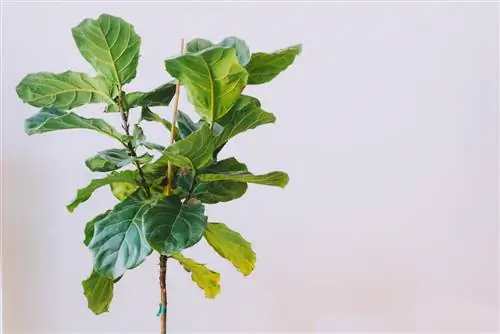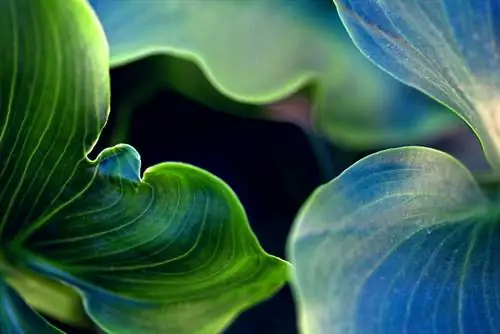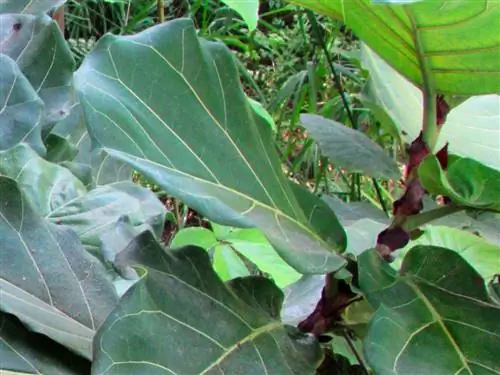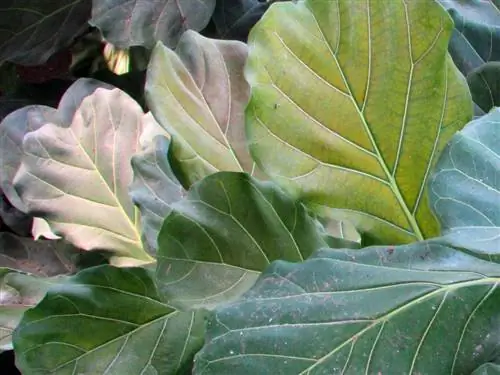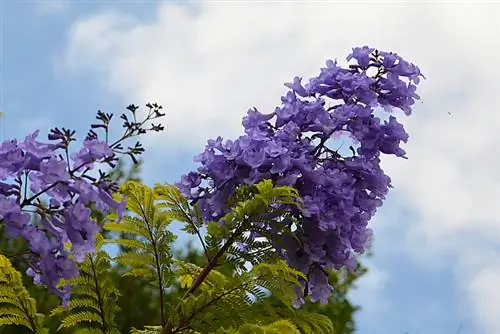- Author admin [email protected].
- Public 2024-01-15 08:07.
- Last modified 2025-01-23 11:21.
Fiddle figs are exotic trees that decorate rooms with their eye-catching leaves. Once it has found the right location, the plant thrives without much care. But there are some things the plant doesn't like.
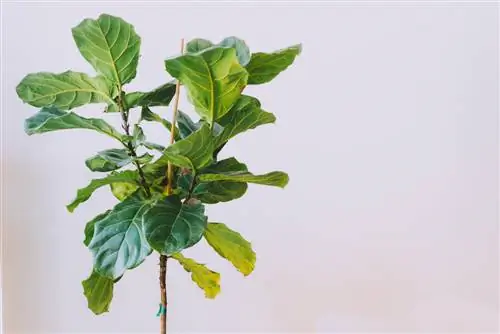
What are the ideal conditions for a fiddle leaf fig?
The violin fig (Ficus lyrata) is a tropical houseplant with large, glossy, dark green leaves that resemble a violin. It grows best in a bright location without direct sunlight, with constant temperatures above 15 degrees Celsius and moderate watering.
Origin
The violin fig is a species of the fig genus. It has the Latin name Ficus lyrata and originally comes from tropical areas. Fiddle figs grow in the rainforests. Their distribution area extends from western to central Africa. It is considered a popular houseplant not only in Europe but also in topical and subtropical regions. As a result, it has spread to many places. In Hawaii there are wild plants that come from cultivated stocks.
Bloom
Fiddle figs develop cup-shaped flowers that are small and inconspicuous. Flowers only form when the conditions are perfect. The specimens cultivated as houseplants bloom very rarely.
leaves
The foliage of these plants was the inspiration for the name. They look as if they have unfolded again after being crumpled up. The leaf edge is wavy and entire. The shape of the leaves is reminiscent of the shape of the well-known string instrument. The leaves are heart-shaped at the base of the blades. Fiddle figs develop leaves in an alternate or spiral arrangement.
Raised leaf veins are clearly visible on the dark green leaves. The entire leaf blade is coarse and leathery. Their surface appears shiny. The leaf blade can be between 20 and 45 centimeters long. The leaves are between twelve and 28 centimeters wide.
Growth
This species grows like a shrub or tree. It is evergreen and does not shed its leaves in autumn. Violin figs grow between ten and 16 meters tall. When cultivated in containers, the plants remain significantly smaller. In the pot, the tree reaches heights of between two and four meters. In their natural distribution area, the plants grow on the ground, as epiphytes on other trees or as strangler figs, which develop aerial roots and use them to entwine other trees.
Usage
Violin figs grow to an impressive size, which is why they are particularly suitable for beautifying high rooms. As a houseplant, they decorate offices or large entrance areas. The attractive green plant has several functions in the workplace. It sets visual accents and improves the indoor climate because its huge leaves have an air-purifying effect.
offshoot
You can successfully multiply your fiddle leaf fig by removing moss. To do this, you have to cut half of a half-woody shoot diagonally so that the branch is still supplied with nutrients by the plant. To prevent the resulting gap from closing, you should clamp a small stone between them. Wrap the base with moistened moss. Finally, to stabilize it, wrap some cling film around the moss. It takes about four to six weeks for new roots to form at the cut site. Then you can remove the foil and moss and cut off the shoot completely.read more
Is fiddle leaf fig poisonous?
All parts of the fiddle leaf fig plant produce a milky sap that escapes when damaged. The liquid may cause skin irritation in sensitive individuals following contact. If leaves are consumed, general malaise may occur. The plant is also poisonous to cats and horses.read more
Which location is suitable?
Violin figs prefer a bright location that receives sunlight in the morning and evening. The brighter the space, the more compact and dense the trees grow. They cannot tolerate full midday sun. A curtain protects the plants from direct sunlight during the midday hours. The plant likes to spend the summer outside in a place protected from the sun. Make sure you choose a location where there are no drafts. Avoid frequent changes of location as this damages the plants.
Temperatures should not fall below 15 degrees Celsius. The plant also thrives under artificial light. However, it should not only be under artificial light. Since the plants don't like cold feet, underfloor heating is ideal. Alternatively, you can place the pot on wooden pallets to insulate the roots from the cold of the ground. So that the plants can spread unhindered, they should not be placed directly in the corner of the room. It's not good for the trees if the leaves press against a wall.
What soil does the plant need?
The trees do not have any great demands on the plant substrate. Young plants thrive optimally in conventional potting soil. Mature plants prefer potting soil. Mix perlite or sand into the substrate. This ensures good permeability so that no waterlogging can form.
The ideal substrate mixture:
- two parts garden soil
- a part compost
- one part coconut hum
In the greenhouse
Fiddle figs originally grow in regions with high humidity. This makes them ideal plants for cultivation in greenhouses, provided they offer enough space. If you plan to grow your fiddle leaf fig in a greenhouse, you should consider the lighting conditions. If the sun shines unhindered on the greenhouse during midday, the plant can be damaged.
Propagate fiddle leaf fig
The trees can be grown from seeds. You can get these from specialist retailers. Since fiddle figs bloom extremely rarely when grown indoors, seed formation is also a rarity. The seeds are scattered on potting soil and moistened. Make sure that the seeds are not covered by the substrate. They are light germinators and need a lot of brightness and warmth. If you cannot provide a bright location, we recommend using a plant lamp.
Cover the planter with a transparent film to ensure high humidity. As soon as the seeds germinate, you should remove the foil.
Another method is propagation through leaf cuttings. To do this, cut a he althy leaf from the mother plant and stick it with the stem into a moist substrate no more than two centimeters deep. Make sure the soil is neither too moist nor too dry. It takes about five to eight weeks for new roots to develop. A new stem develops from the roots and the leaf slowly dies over time.read more
Cuttings
Fiddle figs can be propagated from top cuttings. Cut shoot tips from your plant that are at least 15 centimeters long. Since milky juice comes out of the cut, you should briefly hold the cut end in a bowl of warm water. After the shoot has bled, allow the wound to dry a little.
Then place the offshoot in a planter filled with potting soil. Place a glass or transparent bag over the pot so that the humidity remains constant. Place the growing pot in a bright and warm place and ensure daily ventilation to prevent mold from developing.
The best time to take cuttings is early spring, before the growing season begins. This will prevent the mother plant from being weakened too much and the cuttings will have enough time to develop a he althy root system by winter.
Violin fig in pot
The plants are cultivated as pot plants in Central European latitudes. If there is enough space, they grow into small trees in the container. If you want a bushy growth habit, put two to three plants in a pot. Alternatively, you can remove the shoot tips to encourage branching.
Watering fiddle fig
Fiddle figs have moderate water requirements. Keep the substrate evenly moist and prevent waterlogging and dryness. While the plant dies from lack of water, the roots rot when conditions are too wet. Before you water the plant again, the substrate should be slightly dry.
How to water correctly:
- Substrate is wet after six days: reduce the amount of water
- Soil is dry after two days: slightly increase the amount of water
- top layer dries after three to five days: amount of water is ideal
Fertilize fiddle figs properly
In the first year, the plants do not need any fertilizer. Normally the substrate mixtures in the pots are lightly fertilized. From the second year onwards, the trees enjoy a regular supply of nutrients. Give your fiddle fig some liquid fertilizer (€6.00 on Amazon) via the irrigation water every 14 days. Alternatively, a long-term fertilizer in the form of sticks, pellets or granules is recommended. Fertilize the plant only during the growing season between April and September. Growth stagnates in winter, so fertilization is unnecessary.
Cut the fiddle leaf fig correctly
Pruning is only necessary if you want to reduce the plant height or encourage branching. In this case you can shorten the shoot tips. Prune the plant in spring before the new growth spurt begins. During this time the plant regenerates quickly. The tree does not tolerate pruning measures shortly before winter as well.
You should pay attention to this when cutting:
- Clean cutting tools thoroughly
- Use secateurs or a knife with a sharp blade
- Wear gloves
read more
How do I transplant correctly?
As soon as the pot is heavily rooted, the fiddle leaf fig needs a larger container. For older plants, repotting every two to three years is recommended. The best time for this measure is spring. Fiddle figs can also be repotted in summer. Choose a bucket that is about two finger widths larger than the old one.
Mix some sand into the substrate. You can also use Perlite or Styromull. For a better supply of nitrogen, you can mix some horn shavings into the soil. Before you fill the mixture into the bucket, you should spread pottery shards on the ground. They ensure good water drainage.
Place the plant in the pot and fill it with the freshly mixed substrate. Press the soil well and water the plant thoroughly. After repotting, you should wait six to eight weeks until the first fertilization.
Wintering
The exotic plants are bright all year round. They also thrive in rooms with warm room temperatures in winter, but prefer temperatures between 15 and 17 degrees Celsius. Make sure that the thermometer does not fall below 15 degrees Celsius. The plant is particularly sensitive to drafts and cold feet, especially in winter. Place a Styrofoam plate under the pot to protect the roots.
In winter, a location on the windowsill is suboptimal. The plant suffers from stress when its leaves rest against the cold window pane and are simultaneously exposed to the rising air from the heating system. Place the bucket in a place where the temperatures are uniform. Reduce watering. The cooler the room, the less you need to water. The substrate must not dry out.
Pests
Fiddle figs can be attacked by scale insects, which settle on the trunk, leaf veins and branches. If the infestation is advanced, the leaves change color and die over time. Give the plant a systematically effective agent via the irrigation water, which is absorbed through the roots and distributed throughout the organism with the plant sap.
Infestation by mealybugs or mealybugs can occur. They leave webs on the leaves and secrete a sticky mass. A contact poison provides quick relief. For a long-term effect, you should use systematic remedies. These also help against thrips that settle on the undersides of the leaves and in the depressions of the leaf blades. The affected leaves show silvery or yellow discoloration. Act quickly to avoid major damage to the plant.
If the fiddle leaf fig has been attacked by spider mites, yellowish discoloration will appear on the leaves. The pests lay their eggs on the underside of the leaves and deprive the plants of nutrients. Shower the entire plant with a hard stream of water to remove the pests. If there is a severe infestation, you can use products with neem tree extracts. They have proven to be particularly effective against sucking pests.
Loses leaves
Fiddleleaf figs react sensitively to frequent changes in site conditions. If they are regularly moved to a new place, the plant has to constantly adapt to the new conditions. This adjustment causes stress. Frequently turning the pot in its place causes changes in the incidence of light, which is not good for the plant.
A substrate that is too wet causes the roots to rot. They can no longer draw enough water and nutrients from the substrate, so the leaves slowly die off. As a first aid measure, you should remove the wet substrate from the root ball and place the plant in dry soil. Allow the top layer to dry thoroughly before watering the plant again.read more
Tip
Choose a round bucket with a low center of gravity. The roots get caught more quickly in rectangular plant pots. This makes annual transplanting difficult. Pots with a low center of gravity are particularly important. Violin figs form a lush crown that gains a lot of weight. The pot serves as a stabilizing counterweight.

